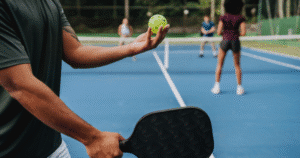
Pickleball continues to grow in popularity across the country, drawing players of all ages to the courts. While it is a fun and social sport, it also comes with a risk of injury particularly in the feet and heels. At Orthopedic & Sports Medicine Center we see many patients struggling with pickleball heel pain caused by overuse, poor footwear, or sudden stops and pivots. The good news is that most of these injuries are preventable with the right approach.
What Causes Pickleball Heel Pain?
The fast movements and quick changes of direction in pickleball place a great deal of stress on the feet. One of the most common causes of heel pain is plantar fasciitis, which develops when the band of tissue that runs along the bottom of the foot becomes inflamed. This condition often creates sharp heel pain that is worst in the morning or after long periods of standing. Another frequent issue is Achilles tendonitis, an overuse injury that leads to stiffness and soreness at the back of the heel. Repeated stress can also cause heel spurs, small bony growths that form along the heel bone, or even stress fractures from the repetitive impact of play. Left untreated, these conditions can make it difficult to remain active on the court.
How to Prevent Heel and Foot Pain from Pickleball
Preventing pickleball heel pain starts with the right preparation. Wearing supportive shoes designed for court sports is one of the most important steps. Running shoes, while comfortable, are built for forward motion only and do not provide the lateral stability needed for pickleball. Stretching the calves, Achilles tendon, and plantar fascia before playing also helps reduce strain on the foot. In addition to stretching, strengthening exercises for the foot and ankle can improve overall stability and lower the risk of injury.
Managing playing time is also important. Long hours of play on hard surfaces can increase the chance of heel and foot problems. Taking breaks and using cushioned inserts or shoes with better support can help reduce the stress placed on your feet. If soreness does appear, listening to your body and giving yourself time to rest is critical. Applying ice to the heel and allowing for recovery before returning to the court can make the difference between a short-term setback and a long-term injury.
When to See a Foot Specialist for Pickleball Heel Pain
While mild soreness often improves with rest, persistent heel or foot pain should not be ignored. If discomfort lasts more than a few days, worsens with activity, or interferes with walking or playing pickleball, it is time to seek professional care. A foot specialist can determine whether the issue is related to plantar fasciitis, tendonitis, or another underlying condition. At OSMC, our podiatry and orthopedic specialists provide thorough evaluations, on-site imaging, and tailored treatment plans that help players return to the court with confidence.
See a Foot Specialist at OSMC
Pickleball should remain a fun and rewarding activity, not a source of chronic pain. If you are experiencing pickleball heel pain, don’t wait until it limits your ability to stay active. The team at OSMC is here to diagnose the cause of your pain and provide the right treatment to get you back in the game. Reach out to learn more about becoming an OSMC patient.


